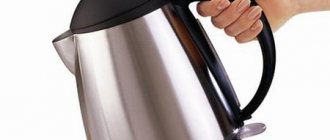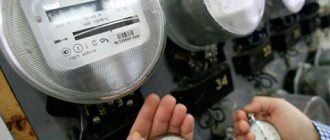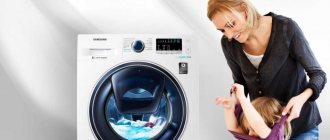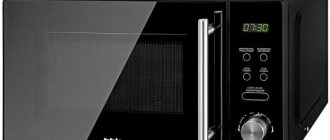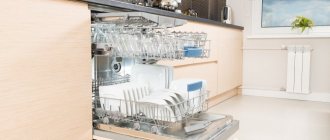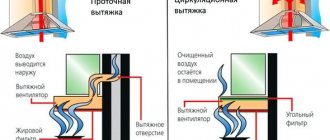What determines the power of an electric kettle?
Although power is a fundamental characteristic, it is necessary to understand that the amount of energy consumed per month depends on many factors:
- flask volume;
- type of heating element;
- water quality, etc.
Power consumption directly depends on the installed heating element. In total, there are 2 types of heating elements used in the production of this type of equipment.
- Open type heating element. Such a heating element is a spiral installed in the device body and in direct contact with the liquid. A device with this type of water heating will make much less noise and perform its task much faster than its “closed” counterpart.
- Closed heating element. Typically, this type of heating element is a special heating plate that is mounted on the bottom of the housing. Although the water heating time and noise level exceed the “open” counterparts, devices with such an element form much less scale.
The average heating time in a kettle with a closed heating element is about 3 minutes. Despite the lower heating rate, modern models are represented by this particular design.
Devices with open heating elements heat the liquid a little faster - in 2-2.5 minutes.
Electric kettle power
Before purchasing a kettle, you need to determine in advance the power of this equipment. It is necessary to focus on ensuring that it is optimal for the conditions in which the equipment will be operated. It is very important to do this, since the wiring of old houses may simply not withstand the load when several powerful devices are turned on simultaneously.
The characteristics of almost all modern models indicate power from 600 to 3000 watts. This indicator is directly proportional to the volume of the kettle - the larger the size, the higher the power. For the home, models with an indicator of 1500 watts are most often purchased. They can boil 1.5-2 liters of water without any problems. The entire process takes from 2 to 4 minutes. Thanks to these characteristics, these kettle models are very popular.
Electric kettle Braun WK 5110 with a power of 3 kW
If you need a device to quickly heat a larger volume of water, then it is recommended to purchase more powerful kettles with an indicator of 3000 watts. They are able to complete the boiling process in two minutes, so they are in demand among owners of establishments where they sell hot tea and coffee.
It is important to remember that particularly powerful types of equipment can seriously load even the newest wiring, especially when a washing machine or air conditioner is working with them at the same time.
All this leads to the fact that the electrics overheat and fail much faster. And replacing it will cost a large sum. In addition, when there is an overload in the network, automatic protection is triggered. And this can have a negative impact on any electrical equipment in the house.
The first teapots
The history of the first teapots is connected with the birthplace of tea - China.
The very first teapots were made using red clay, which was located near the city of Yixing. Only masters were involved in their production. The most important thing about this clay is that it has a porous structure. Thanks to this, it prevents liquid from leaking out and allows air to penetrate from the surrounding space so that oxygen can saturate the tea. In those days, it was believed that it was in teapots made of this clay that it was best to brew an aromatic elixir, since the aromatic and taste characteristics of this drink were fully revealed and it retained its beneficial properties longer. These teapots made the drink taste better every time you brewed it. This happened because each pore of the kettle was filled with beneficial enzymes and essential oils. Several teapots made from Yixing clay have survived in modern China. You can pour boiling water into them and after five minutes drink real aromatic tea.
Traditions of Japan
The cult of tea came to Japan in the sixteenth century. After the appearance of the tonic drink, tea quickly gained worldwide fame. The Japanese came up with a huge number of new ways to brew the drink, and the Japanese tea ceremony became known throughout the world. A manufacturing industry emerged dedicated to making teapots only. Any teapot was treated as a work of art. It was decorated using various methods. Masters painted beautiful pictures on the surface of the teapots. One of the progressive centers of teapot production is the Bizen province.
When did teapots appear in Europe?
In the 16th century, having conquered Japan, tea began to conquer Europe. Of course, along with tea, a teapot also came to the Old World. True, only one portion of tea was placed in such a container. The kettle did not yet look like its modern counterpart. It looked more like a small clay pot. Its appearance was a cross between a Turkish coffee pot and a wine vessel from Spain. In those days, teapots from Europe were much more ugly, rude, and less elegant than their eastern counterparts.
Europeans began making teapots on their own in the late 70s of the 17th century. Only then were Dutch craftsmen able to create a product that could withstand high temperatures. A few decades later, dishes made of metal began to appear. In the 18th century, teapots began to be made from porcelain. Then they acquired their traditional shape and were able to compete with teapots from China. Later, these dishes began to be made from tin and silver. The appearance of the kettle has hardly changed since those times.
How to calculate electricity consumption
It is quite simple to understand how much electricity a kettle will consume. To do this, just perform a simple calculation. As a basis, you can take a device with a power of 2000 watts and imagine that it will boil water 4 times a day for 4 minutes. In an hour, such a kettle consumes 2 kilowatts of electricity. Accordingly it turns out:
- consumption per minute - 33.3 watts;
- for 4 minutes of boiling - 133.3 watts;
- consumed per day - 133.3x4 = 533.2 W or 0.53 kW;
- per month it turns out 15.9 kW;
Then you can simply calculate the costs. At a cost of 1 kW of 3 rubles, you will have to pay 1.59 rubles for boiling water, and 47.7 rubles for a month. One boiling will cost about 40 kopecks.
You can use a wattmeter to measure energy consumption
This calculation was made to the maximum, since it did not take into account the fact that when reheating the water is not always brought to a boil. If the average calculation does not suit you, then you can find out the consumption for a specific kettle. To do this you need to do the following.
- Find out the power of the kettle. It is indicated on the box or in the instructions. If there is neither one nor the other, then you can look it up on the Internet.
- After this, you need to measure how long it takes to complete the boiling process.
- Next, 60 minutes is divided by the boiling time (for example, 3 minutes). The result is a coefficient of 20.
- After this, the power of the kettle is divided by the resulting number. Let the device have a rating of 2400 watts, then 2400/20=120 Watts for 3 minutes of boiling. Or 0.12 kW. To get the cost of one boiling, you need to multiply 0.12 by 3 rubles. It will turn out to be 36 kopecks.
- To calculate the cost per day, multiply this figure by the number of boils per day.
Kettle or thermopot – which is more economical?
To find out, you can do an experiment. For this, the following household appliances are taken:
- kettle Bosh TWK 7801;
- thermopot Maxwell MW-1752.
Kettle characteristics: power 2200 W, volume – 1.7 liters. The thermopot has, respectively: 890 W and 6 liters. Testing is carried out using a wattmeter, and the cost of electricity is 3 rubles per kilowatt-hour.
Bosh TWK 7801 kettle and Maxwell MW-1752 thermopot
1.7 liters of water is poured into each device and brought to a boil. It took the kettle 6 minutes to do this. During this time, he spent 0.17 kWh for the amount of 51 kopecks. The thermopot completed this task in 16 minutes, spending 0.39 kW or 1.17 rubles.
However, this calculation is not entirely fair, because the thermopot was originally designed to heat and maintain a high temperature of a large volume of water. Therefore, another experiment is carried out with 6 liters of water. The thermopot boiled it in 40 minutes and 3.15 rubles (using 1.05 kW). It will take about 20 minutes for a kettle to boil the same volume of water. During this time, it will consume 0.6 kW of electricity or 1.8 rubles. The same flow ratio will be if you conduct a daily study.
Although the experiment was very approximate, the following can be seen from it: it is cheaper to boil water using a kettle, but a thermopot is necessary when it is necessary to maintain a high water temperature.
PHILIPS HD9321/20
A model for those who need a so-called non-killable option that can last a long time. Its characteristics will remain normal even after repeated use.
Electric power kettle is 2,200 watts, which allows you to get boiling water in a short time. The device has no unnecessary functions, is durable and has a laconic design. Among its advantages:
- scale filter;
- The stand is wireless, which allows you to install the device at any angle;
- metal body and unheated plastic handle;
- convenient volume of 1.7 liters;
- disk heating element.
This model is chosen by consumers who value the reliability and durability of the product. It fully fulfills its functions, but this kettle is in a high price category.
How much do other household electrical appliances consume?
For comparison, here is the average energy consumption of major household electrical appliances:
- washing machine – 20-25 kW/month;
- computer – 30 kW/month;
- refrigerator – 30 kW/month;
- TV - 35 kW/hour.
As you can see, the kettle does not have such a high power consumption. But if you are a little more careful and calculate the amount of time that all devices work, it will become clear that the kettle and iron consume the maximum amount of energy in the minimum amount of time.
How you can save energy consumption
So, a kettle can be classified as a fairly uneconomical device in terms of energy savings. However, following some recommendations, you can reduce your consumption slightly.
- If you are not using the kettle, unplug it. Even in standby mode, the equipment consumes a certain amount of electricity.
- Boil only the volume of water that you currently need for tea drinking or other purposes. After all, in order to heat 2 liters of water, it will take 2 times more energy than to heat 1 liter. There is no point in pouring water to the maximum level to drink one cup of tea.
- Regularly clean the heating element of the device (and indeed the entire internal surface) of scale. The presence of sediment makes the process of boiling water longer and, therefore, more energy-consuming. In addition, the heating element may generally fail if there is a large layer of scale on it.
- If you think that boiling water on an electric stove is more economical, you are mistaken. In this regard, the kettle benefits significantly - it will heat the water faster and with less energy consumption.
How to choose a good electric kettle?
When choosing an electric kettle, pay attention to the following parameters:
Boiling speed
We expect an electric kettle to boil as quickly as possible. Typically, the higher the power of an electric kettle, the faster it boils. But devices with high power put a heavy load on the electrical network (this point must be taken into account when choosing a kettle, for example, for a summer house or for business trips).
Noisiness
In some cases (in the office or when a small child is sleeping), it is desirable for the kettle to boil almost silently. Some devices, especially those with a metal body, boil water so noisily that it becomes a real problem.
Availability of additional options
Additional functions (several temperature settings, long-term boiling, control from a smartphone, etc.) make using the kettle more convenient and save energy.
Safety
When using an electric kettle, the consumer faces the risk of being burned by steam or a hot body, or by absent-mindedly turning on an empty electrical appliance. It’s good if all the details for safe operation are thought out, starting from the shape and material of the case and ending with the system for blocking the inclusion without water.
Price
Of course, the cost must be assessed individually for each model. But still, few people will buy a kettle for the price of a good dishwasher.
Reviews
We selected the best electric kettles that have proven themselves in operation and have earned positive reviews from experts and customers.
